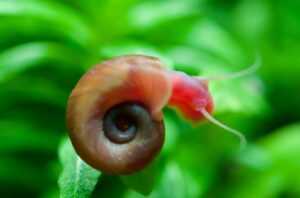
Bladder Snail Eggs: Everything You Need To Know

Writer at The Aquarium Keeper
Aquariums are complex ecosystems, and occasionally you can even expect unwanted visitors in your fish tank too. Bladder snails are one of those unwanted guests, that can suddenly appear in your aquarium. Some fish keepers love these snails, while others really despise them.
If you have these creatures in your tank, you would need to know more about bladder snail eggs, since the information in this article will help you identify bladder snail eggs, control their population, or overall get rid of these unwanted bladder snails.
What is a Bladder Snail?
Bladder snails are the most basic and common aquarium snail species, that can be found pretty much everywhere. An individual bladder snail both have male and female reproduction organs, which makes them breed very often and quite easily. They live in rivers, ponds, and lakes. It is truly unknown, where bladder snails originate from, but some people think, that they are from Europe, while others believe, that these species come from North America. Bladder snails are relatively hardy for their size and can live in different water conditions. Here is more information about these species:
- Scientific name: Physella acuta
- Rarity: Common
- Price: 0.25$-1$ per snail
- Care level: Easy
- Water Temperature: 18–28 °C (64–82 °F)
- pH: 7.0–8.0
- Water Hardness: 100—250 ppm
- Minimum Tank Size: 5 gallons
- Diet: These small snail species can eat anything, that they can find in an aquarium, including algae, decaying plants, leftover fish food, deceased tank mates
- Temperament: Very peaceful
- Lifespan: Up to 1 year
- Breeding: These species simply lay clusters of eggs, which result in a very fast-growing bladder snail population
- Size: up to 0.5 inches (1.2 cm)
Bladder snails are not one of the most aesthetically pleasing species, compared to other aquarium snails. They have slightly transparent shells with dark spots on them, and two antennas, which help these species navigate their surroundings. They are one of the most basic-looking aquatic snails in this hobby.
Are Bladder Snails Pests?
Lots of people consider these species as pests since they appear in an aquarium randomly. Nevertheless, bladder snails are excellent at eating leftover food and algae, so they can be a good clean-up crew for a tank. Whether you consider these snails as pests or not, is solely up to you.
They can become a nuisance if the population is out of control. A large number of bladder snails can easily increase ammonia levels in an aquarium and in general ruin the visual representation of your fish tank. If you like these snails and want to keep them, continue reading this article, to find out how to control the bladder snail population.
You might also like to read: 16 Types of Aquarium Snails You Should Have
How do Bladder Snails Get Into Aquariums?
Bladder snails are notorious for appearing in aquariums unexpectedly. The main way of bladder snails gets into your tank is through newly added plants or decorations. Most aquarium keepers usually buy their plants or decorations from other hobbyists, since it is a cheaper alternative, than buying from fish stores.

Sometimes these plants can have bladder snails or their eggs attached to them. In other words, bladder snails can easily hitchhike from one aquarium to another through newly added things in the aquarium. Only a very small amount of people sell aquatic plants, that don’t have bladder snails on them, since it requires more effort and work to remove them from the plants.
Can You Breed Bladder Snails?
Bladder snails are extremely easy to breed. Even though some people despise these species, some aquarium keepers try to breed them and sell them for profit. Since they are very common, it is very unlikely, that there would be a lot of buyers for bladder snails.
Here are basic steps, on how to successfully breed bladder snails:
- Set up a separate breeding aquarium, that should be at least 10 gallons and only for bladder snails
- Make sure the water temperature is at 18–28 °C (64–82 °F), and the pH is at 7.0–8.0
- Feed your snails daily, and make sure to remove any large amounts of excess food, since it can go bad and cause an ammonia spike in your tank
- Be patient and wait. By introducing good water parameters and enough food, bladder snails will be encouraged to breed and will soon start laying eggs
- Bladder snails usually reach maturity at around 1-2 months, so they will quickly start breeding
Bladder Snail Eggs
Moving on, it is important to understand more about bladder snail eggs. Whether you want to completely remove these snails, or only monitor their population in your tank, you have to know, how to deal with bladder snail eggs.
How do Bladder Snails Look?
When it comes to appearance, bladder snail eggs are very basic, and can be easily spotted in an aquarium. Bladder snail eggs are usually in larger clutches (at least 10-40 eggs) and are white or grey in color. Sometimes the eggs can also be partially transparent. The older the eggs get, the more gray or brown they turn.

As I mentioned before, bladder snails reproduce quickly, and the reason for that is that their eggs usually hatch between 1-2 weeks after being laid. A lot of the time nearly all eggs hatch successfully, but not every bladder snail reaches adulthood, some become sick and die, and others can’t find enough food.
You might also like to read: What To Do With a Dead Snail in a Fish Tank?
Where do Bladder Snails Lay Their Eggs?
Bladder snails are not really picky when it comes to choosing a place for their eggs. Bladder snail eggs can be found everywhere: on decorations, plants, filters, and glass. These species can lay their eggs on almost any surface, which is why it is so easy to get infested with bladder snails from newly introduced decorations or plants.
What to do With Bladder Snail Eggs?
Moving on, when you see bladder snail eggs in your fish tank, now is the time to make a decision, whether you want these snails in your aquarium, or not. Based on your decision, there are guidelines written below, on what you can do with bladder snail eggs in your tank.
Keep Bladder Snail Eggs
If you decided, that you want bladder snails in your fish tank, then you should simply do nothing with bladder snail eggs. Let these aquatic snails breed in your aquarium, and only intervene, if the population for your liking is too big, or the water parameters start to change.
Manual Removal of Bladder Snail Eggs
Manually removing bladder snail eggs is probably the easiest way of reducing the population, although it can be tricky to find all of the eggs. Bladder snails love to lay their eggs in all sorts of places, and some of them are hardly accessible by hand. Nevertheless, you can try to use your fingers to scrub off any eggs from glass, decorations, and plants.
Another manual removal method is using a siphon. You can try to remove the eggs while changing your aquarium water, but it does not work always, since not every siphon can suck bladder snail eggs off of decorations. You can also use a sponge to gently scrub bladder snail eggs off.
Quarantine New Plants And Decorations
If you already have a bladder snail problem, make sure that no additional bladder snails get into your aquarium through new plants or decorations. If you have the capacity, create a basic quarantine aquarium, where you would keep your newly purchased decorations and plants. If there are any bladder snail eggs, they would hatch in that tank, and not your main aquarium.
If you can’t have a quarantine tank, always make sure, that you scrub off any snail eggs, that are on your new plants or decorations, so there would be less chance of a new bladder snail infestation in your tank. Carefully inspect your new purchases, and rinse them in slightly hot water. This step doesn’t particularly help remove existing bladder snail eggs, but it helps to build a habit of prevention for other possible snail problems in the future.
Reduce Amount of Food
So there is a high chance, that you won’t be able to find all bladder snail eggs in your fish tank, and some will hatch into small bladder snails. A simple and good way of getting rid of them is to reduce the amount of food, that is given to that tank.
If bladder snails can simply thrive from the leftover food, that they find, there is a good chance, that you are already overfeeding your aquarium. Try to add just enough food for your pets to fully eat, and there is a chance, that the number of new bladder snails popping up in your tank will drastically reduce.
Introduce Snail Eaters
Another good way of removing bladder snail eggs is to introduce certain species, that eat them. Here are aquatic creatures, that can eat bladder snail eggs:
- Assassin Snail
- Neocaridina Shrimp
- Amano Shrimp
- Pea puffer
- Betta Fish
- Loaches (Yoyo loach, kuhli loach, zebra loach, dwarf loach)
- Gouramis (honey gourami, dwarf gourami)
Keep in mind, that there is no guarantee, that these species will eat bladder snail eggs. Every creature has a different character, and some may see bladder snail eggs as food, and some may not.
Frequently Asked Questions
How Often do Bladder Snails Lay Their Eggs?
Bladder snails have a very high reproduction rate, meaning that they can lay from 50 to 100 eggs per week. There is no guarantee, that every egg will hatch, but this high reproduction rate will guarantee a fast bladder snail population growth.
Are Bladder Snails Invasive?
In terms of fish keeping, they are invasive, since they appear in your aquarium unwantedly. In terms of nature itself, bladder snails are not considered invasive, since they are already available all around the world.
Writer's Thoughts
Bladder snails are good when it comes to cleaning an aquarium, but they can be a problem sometimes. I like these species, but they do need extra attention when it comes to population control. Make sure to occasionally remove some bladder snails, if you don’t want them to overpopulate your aquarium.
If you enjoyed reading our article, please feel free to share it with your friends by clicking the social media buttons below:


What Vegetables Can Guppies Eat? Vegetable Preparation Guide




